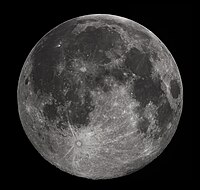
Photo from wikipedia
Abstract Mare basalt sources and ferroan anorthosite suite cumulates define a linear array on a 146Sm/144Nd versus 142Nd/144Nd isochron plot demonstrating these materials were derived from a common reservoir at… Click to show full abstract
Abstract Mare basalt sources and ferroan anorthosite suite cumulates define a linear array on a 146Sm/144Nd versus 142Nd/144Nd isochron plot demonstrating these materials were derived from a common reservoir at 4336+31/−32 Ma. The minimum proportion of the Moon that was in isotopic equilibrium at this time is estimated to be 1-3% of its entire volume based on the geographic extent from which the analyzed samples were collected and the calculated depths from which the samples were derived. Scenarios in which large portions of the Moon were molten to depths of many hundreds of kilometers are required to produce the observed Sm-Nd isotopic equilibrium between the mantle and crustal rocks at 4.34 Ga. This is a consequence of the fact that limited heating of a solid Moon above the blocking temperature of the Sm-Nd isotopic system is insufficient to diffusively homogenize radiogenic Nd throughout the mantle and crust. There are three scenarios that might account for global-scale isotopic equilibrium on the Moon relatively late in Solar System history including: (1) Sm-Nd re-equilibration of a solid Moon resulting from widespread melting in response to mantle overturn or a very large impact, (2) early accretion of the Moon followed by delayed cooling due to the presence of an additional heat source that kept a large portion of the Moon molten until 4.34 Ga, or (3) late accretion of the Moon followed by rapid cooling of the magma ocean late in Solar System history. Neither density-driven overturn of the mantle, nor a large impact, are likely to homogenize the mantle and crust to the extent required by the Sm-Nd isochron. Likewise, secondary heating mechanisms, such as tidal heating or radioactive decay, are not efficient enough to keep the Moon molten to the depth of the mare basalt source regions for many tens to hundreds of millions of years. Instead, the age of equilibrium between such a compositionally diverse set of rocks, produced on a global scale, likely records the time of primordial solidification of the Moon from a magma ocean. This scenario accounts for both the petrogenetic characteristics of lunar rock suites, as well as their Sm-Nd isotopic systematics. It is supported by the preponderance of ∼4.35 Ga ages obtained for other hypothetical magma ocean crystallization products, such as ferroan anorthosite suite rocks and K, REE, and P enriched cumulates that are thought to represent flotation cumulates of the magma ocean and the last vestiges of magma ocean solidification, respectively.
Journal Title: Earth and Planetary Science Letters
Year Published: 2019
Link to full text (if available)
Share on Social Media: Sign Up to like & get
recommendations!